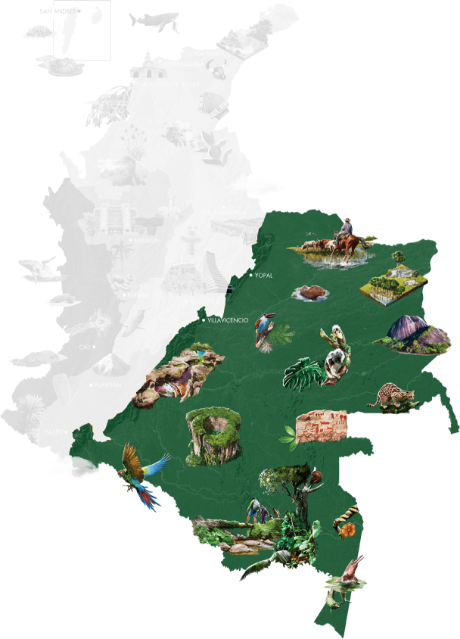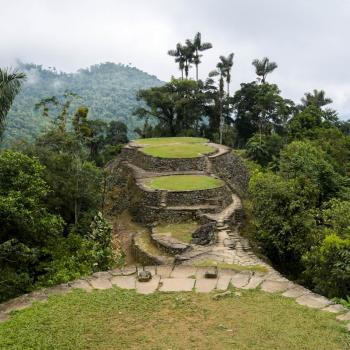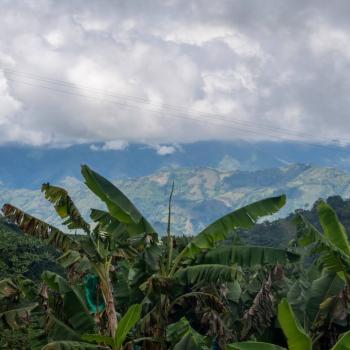An awe-inspiring blanket of green that spreads as far as the eye can see, the sacred forests and sweeping plains of the Colombian Amazon-Orinoco are a bastion of biodiversity and one of the world’s last great wildernesses.
Made up of two distinct but complimentary ecosystems - the grand grasslands of the Orinoco River basin in the north and the pristine old growth forests of the Amazon in the south -the vast green heart of Colombia is a place of colossal open skies and monumental rivers that is unlike any other.
A place where llanero cowboy culture is awash with stories of harsh life on the plains and enduring indigenous communities guard not just the natural world but priceless ancestral knowledge, these mystical lands are as diverse as they are immense.
Home to the world’s most beautiful river and some of the oldest recorded prehistoric art, this is a destination that educates and enthralls, a place where authentic adventure lies around every corner.
While its famed for its enormous ranches where cattle roam freely amongst curious capybaras and herds of deer, there is much more to the Orinoco than just farmland. The region’s pristine grasslands and stunning wetlands house great populations of mammals and a plethora of migratory birds and it’s the best place in the country to catch a glimpse of elusive big cats.
The eastern limits of the Orinoco are sprinkled with huge smooth stone monoliths that jut out from the otherwise flat riverscapes like massive molehills and can be climbed for tremendous views of in all directions.
During the dry season, when animal populations gather around dwindling water resources, the concentration of wildlife here has to be seen to be believed, as do the glorious sunsets. And it is after sunset on these frontier ranches that plains culture bursts to life with sweet sounds of the harp and the exuberant steps of the joropo, the region’s traditional dance.
If the paces of the joropo seem challenging, spare a thought for the practitioners of the region’s favorite sport, the coleo, which involves mounted cowboys bringing wild bulls to the ground by grabbing them by the tails.
Heading south from the Orinoco, the plains and ranches gradually give way to the thick vegetation of the Amazon, the world’s largest tropical forest and an endless natural wonderland of adventure and mystical encounters.
This impenetrable forest shelters thundering waterfalls, giant lilies and delicate orchids in addition to a world of legends, the secrets of which are passed from generation to generation by the area’s indigenous inhabitants.
Where else but in the Amazon can visitors observe playful pink dolphins frolic from the riverbank with brightly plumed macaws for company or navigate a flooded forest in a traditional dugout canoe in search of colonies of rare monkeys.
Both the Orinoco and the Amazon are must visits for nature aficionados, but it is in the area where these two habitats blend together that the region’s most spectacular attraction can be found.
Known as the river of five colors, for part each year, Caño Cristales appears like any other picturesque jungle stream: a relaxing transparent waterway surrounded by tranquil nature. But from the end of June until November, algae native to the river burst into bloom, turning its waters into a riot of brilliant reds and oranges that contrast delightfully with the green foliage lining the river bank.
The river is part of the Sierra de la Macarena national park which also boasts waterfalls and swimming holes in addition to an impressive array of flora and fauna. Another majestic waterway can be found to the north of the park where the the Rio Güejar passes through a stunning canyon.
But the Macarena is not the only unmissable national park in the region. The Serranía de Chiribiquete is an enormous tract of rugged wilderness that houses the largest collection of ancient cave paintings and petroglyphs on the continent. Protecting an impressive array of flora and fauna, these mysterious mountains have been listed as a World Heritage Site for both their cultural and ecological importance.
Other fine examples of prehistoric art can be found at Raudal Angostura where intriguing petroglyph-covered rocks line a rushing river.
While the artists of Chiribiquete and Angostura have long since disappeared, the Colombian Amazon-Orinoco is also home to fascinating living cultures.
One of the best places to get to know the cultures and traditions of the jungle is in the regional capital of Leticia, the southern most city in Colombia which is perched on the banks of the mighty Amazon river at the triple border with Peru and Brazil. With no roads in or out, Leticia is a peaceful oasis surrounded by some of the most dense and untouched tropical rainforest in the Americas.
Residents from indigenous communities all over the region come to Leticia in search of supplies and to socialize, giving the city a unique energy thats best observed around the busy dock. It also has an excellent ethnological museum that is a great place to learn about the cultures of the region before heading deeper in to the jungle to destinations such as the Amacayacu National Park.
Even more laid-back is the traffic free village of Puerto Nariño around 80km upstream. Colorful and welcoming, its the perfect place to get a taste of life in a modern jungle community and the jumping off point for the Tarapoto Lake - one of the Amazon’s most elegant bodies of water.
Another wonderfully remote jungle community well worth a visit is Mitú, the capital of Vaupes department. Located on the banks of the gorgeous Vaupes river with its golden sand beaches backed by lush jungle, tiny Mitú is the main departure point for the rarely visited Jirijirimo waterfall.
Surrounded by the thickest of jungle, it is here that the gentle Apaporis River bursts into life in a series of powerful cascades that throw mist high into the air. It is without doubt one of the most spectacular natural wonders in the country not to mention one of the most isolated.
Matching Jirijirimo for isolation are the splendid Cañon de Araracuara where the Caqueta River passes between immense jungle covered cliffs and Tuparro National Park which protects beautiful tracts of the Orinoco River.
The remote locations of many of the attractions in the Colombian Amazon-Orinoco means that air travel is often the best - or only - way to get around. The closest international airport to the region is El Dorado in Bogotá.
From the capital flights depart to many parts of the Colombian Amazon-Orinoco while flights to some other more remote destinations depart from Villavicencio - the portal to the Orinoco, three hours from Bogotá by road.
Other road access points to the region include Yopal in the Orinoco which connects with Boyaca department in the Colombian Eastern Andes via a scenic mountain highway and Florencia in the Amazon which is just a short drive from the Colombian Massif.
During the dry season it’s possible to drive deep into the Orinoco with a good all-terrain vehicle.









































